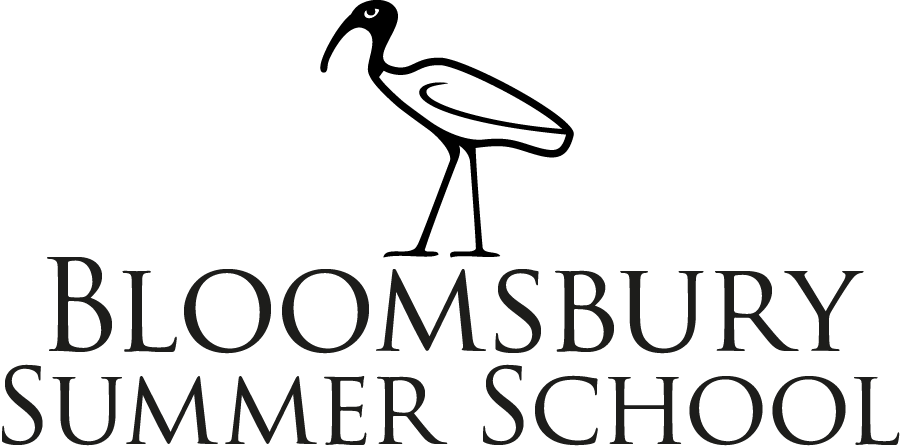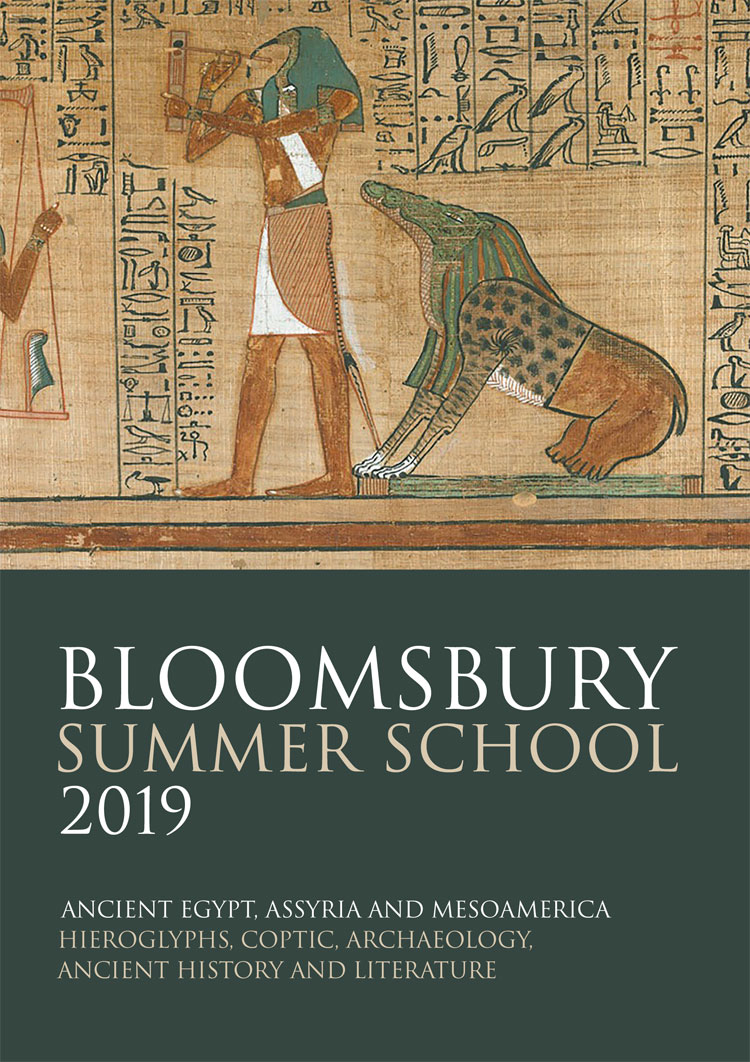
Bloomsbury Summer School

Fascinated by ancient civilisations?
We offer anyone with any level of knowledge, inspiring short courses on ancient Egypt and other areas of the ancient world.
Summer School 2019 – programme (archived)

Monday 24 – Friday 28 June 2019
Coptic for Beginners
Course Director: Dr Bill Manley
We were delighted that Dr Bill Manley reprised his unique introduction to Coptic course for us this year. Coptic was the language of the early Christians of Egypt, and the final phase of the ancient language of the pharaohs. Our Beginners course offers you the knowledge and the practice required to begin reading important groups of ancient texts, highlighting the wisdom of the 4th-century desert fathers and the lives of monks and wealthy villagers at Thebes in the aftermath of the Arab invasion.
Monday 1 – Friday 5 July 2019
Reading Coptic
Course Director: Dr Bill Manley
Our hieroglyphs courses have been highly-regarded for many years, and we are thrilled that our recently-introduced Coptic courses are now so well appreciated too. We were so pleased that Dr Bill Manley taught a brand-new course, designed to build on your elementary skills in reading Coptic. This new course written by Bill concentrated on exemplary groups of Coptic texts from the 4th century to the decades following the Arab invasion, including letters, narratives and sermons by notable authors such as Shenoute and Frange.
Monday 1 – Friday 5 July 2019
Ancient Egypt Rediscovered: New methods and techniques in Egyptology
Course Directors: Dr Lidija McKnight and Dr Iwona Kozieradzka-Ogunmakin
Following on from the success of Lidija and Iwona’s 2018 BSS course on Saqqara, they returned in 2019 to co-direct a course based on the investigation of the ancient Egyptian civilisation using modern techniques. An enduring fascination with Ancient Egypt drives enthusiasts and researchers alike to study the wealth of surviving evidence, to discover more about the lives, deaths and beliefs of these ancient peoples. Advancements in modern technology enable ancient archaeological sites, cultural artefacts, art and documentary sources to be interrogated in new and exciting ways. Most importantly, the emphasis is placed on the information that can be gained through non-invasive and non-destructive investigations, preserving the integrity of the material for the future.
This exciting new course presented a wide range of new methods and techniques used to investigate various aspects of ancient Egyptian archaeology: landscape; architecture; artefacts; human, animal and organic remains. Through a series of lectures and museum visits delivered by world-leading experts, this course demonstrated how these innovations contribute to, and enrich, our understanding of ancient Egypt and its people.
Monday 8 – Friday 12 July 2019
Hieroglyphs: The next step
Course Directors: Dr Bill Manley and Dr José R. Pérez-Accino
We were delighted to offer once again our second-stage course in Egyptian Hieroglyphs. José Pérez-Accino and Bill Manley returned to show you The Next Step, which builds on the knowledge and skills acquired on the course Hieroglyphs for Beginners. In a series of practical sessions you were introduced to increasingly elaborate monuments, including those made for kings as well as officials. In this way you learnt more sophisticated aspects of hieroglyphic writing and the language, including ways of talking about the king and the gods; talking about the past, present and future; and making negative statements. Through the week you enriched your understanding of different kinds of monuments and expand your knowledge of Middle Egyptian.
Monday 8 July – Friday 12 July 2019
Reading Hieroglyphs: Praise and betrayal
Course Directors: Dr Bill Manley and Dr José R. Pérez-Accino
As ever, we staged a course especially for those of you who love to discover Ancient Egypt through reading ancient texts. This year we were delighted to offer a brand new course based on a well known but not well understood event – the assassination of king Amenemhat I, founder of the 12th Dynasty. Together we read the essential account from The Teaching of Amenemhat I and also delved into contemporary texts, which discuss distinctive beliefs and words regarding the king and his relationship with his courtiers and the people of Egypt. Some of you chose to study certain passages in the original hieratic to improve your reading in both the ancient language and writing.
Monday 15 July – Friday 19 July 2019
Ancient Egypt in 100 People
Course Director: Dr Campbell Price
We staged this new course in response to all the positive feedback following Dr Campbell Price’s sell-out course for us last year: Ancient Egypt in 100 Objects. So, by popular demand, he moved from objects to people: interesting characters from Egypt’s ancient past.
Elite Ancient Egyptians strove to be remembered for eternity. This new course used the significant evidence for ancient Egyptian individuals to chart a biographical history of the Pharaonic state through 100 people. Rather than kings and queens, you examined the non-royal people who made a mark sufficiently indelible to be remembered more than 2000 years later. We analysed the various strategies employed in élite self-presentation; the nature and extent of the evidence for the élite (as opposed to the non-élite); and the meanings of individuals’ names, in this exploration of text and image.
This course included sessions taught in The British Museum and UCL’s Petrie Museum of Egyptian Archaeology.
Monday 15 July – Friday 19 July 2019
War, Strife and Conquistadors: Mesoamerica in the postclassic period
Course Director: Dr Elizabeth Baquedano
Last year we staged for the first time, an introduction to Mesomerican history and archaeology. Elizabeth Baquedano’s course was so popular that this year we brought you a more focussed course on this part of the world, this time exploring the Mesoamerican Postclassic Period (AD 900-1521). This era was a fascinating one, combining innovation, creativity and strife. We examined a period of Mesoamerican history characterised by warfare among different peoples with larger populations than ever before. Archaeology revealed the defensive character of sites, and cities built with walls for protection. The art reflects this time of conflict - many sculptures and paintings depict fully armed warriors.
This course explored politics, religion and warfare, and how closely they were interwoven. This period of Mesomerican history is distinguished too by exciting cultural developments - new standardised forms of pictorial writing and iconography, and a new ritual ideology. We examined the material culture peculiar to this time of hostility – warriors feature in the iconography found, for example, on religious structures and musical instruments. We also studied the nature of the Toltec capital, Tula; the Mayan cities of Chichen Itzá and Mayapan; as well as the Aztec and Tarascan Empires; and the arrival of the Spanish Conquistadors in 1519. =
This course included teaching in The British Museum.
Monday 22 July – Friday 26 July 2019
Ancient Assyria: Power and ideology
Course Director: Professor Lloyd Llewellyn-Jones
If today the Assyrians are remembered at all, they are usually encountered through their image in the Bible in which they are found as an imperial power, which destroyed the kingdom of Israel and took the ‘twelve tribes’ into captivity. A generation later they attacked Jerusalem, the capital of Judah. It is this attack, which inspired Lord Byron to write:
The Assyrians came down like a wolf on the fold
And his cohorts were gleaming in purple and gold.
Largely in consequence of the Bible and of Byron’s poem, the Assyrians have the reputation for ruthless savagery. They have been much maligned. Certainly the Assyrians could be merciless in their maintenance of order, but they were the defenders of civilisation, not barbarian destroyers.
This course explored the nature of life and thought during the time of Assyria’s apogee, when it ruled a huge empire and was governed from great cities such as Nineveh and Nimrud. Through a combination of textual studies, archaeology and the examination of material culture, this course explored the ideology of empire and of kingship, as well as the literature, art, religion, and daily life of the Assyrians. Attention was also be given to the archaeological ‘rediscovery’ of Assyria and analysis of the recent destruction of Assyrian sites by ISIS, with an eye to the future progress of Assyriological research.
This course included a session taught in The British Museum.
Monday 22 July – Friday 26 July 2019
Ancient Egyptian Literature in context: A voyage through history, culture and religion
Course Director: Dr Luigi Prada
There is no doubt that ancient Egyptian literature belongs to humanity’s cultural heritage, as one of the world’s greatest literary traditions. With a text production spanning more than three millennia, from its written beginnings in the Old Kingdom through to its Coptic manifestation in Late Antiquity, it can pride itself on an incredibly prolific and varied textual corpus, including myriad genres, from religious hymns to pornography. And yet, so many of ancient Egypt’s literary treasures are still hardly known outside the walls of academia.
This course offered a full diachronic discussion of ancient Egyptian literature. Both its famous masterworks and its lesser-known gems were presented and discussed in their historical context, through a series of lectures that introduced the students to ancient Egyptian literary criticism, problems of interpretation of the original manuscripts, and—most importantly—to the social, cultural, and religious milieus from which these works of art originally stemmed. Participants discussed translations of Egyptian texts with the course director, in order to develop their own skills as critical readers of ancient texts.
This course included a session taught in the Petrie Museum of Egyptian Archaeology.


